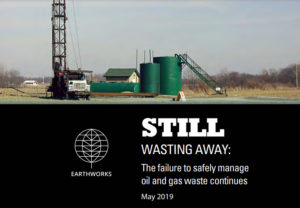Note: An update of this report, Still Wasting Away, was released in 2019.
From the introduction:
Nearly 30 years ago, before the shale boom was even a gleam in the oil and gas industry’s eye, the United States Environmental Protection Agency (EPA) considered whether oil and gas development waste should be regulated under the Resource Conservation and Recovery Act (RCRA). Among the agency’s many conclusions in a report to Congress were:
- Such wastes “contain a wide variety of hazardous constituents.”
- “Regulatory gaps exist.”
- “[Waste management] practices vary substantially in the protection they provide to the environment.”
- “For the major waste streams, EPA was unable to identify any new technologies…that offer promise for wide application in the near term.”
Despite these conclusions, EPA decided to exempt oil and gas development waste from the definition of “hazardous” under RCRA.
As the saying goes, the more things change, the more they stay the same. Between 1995 and 2009, the number of oil and gas wells in production grew more than 20% (141,000); by 2013, natural gas wells had increased more than 65% (189,000) and the average rate of oil production had gone up nearly 40%. Today, there are more than 1.1 million active oil and gas wells nationwide.
Most of these wells are hydraulically fractured and all of them produce large quantities of liquid and solid waste. Yet RCRA still does not apply to oil and gas development waste. Consequently, it is categorized as non-hazardous and its management is largely subject to state discretion.
At the same time, many of the questions asked about oil and gas field waste decades ago persist, including what it contains and how it is, and should be, treated and disposed of. Also debated is whether states have the ability and resources to adequately protect water, soil, and air quality in the process.
A series of high-profile events has drawn public attention to the limitations and risks of current disposal facilities and methods. In addition, research studies and investigations have begun to document the contaminants present in oil and gas field waste and the pathways through which they enter the environment—and can ultimately impact human health. As more problems with waste storage and disposal capacity have grown alongside the number of wells and scale of operations, many policymakers and advocates have started to ask: as drilling continues, where is all the waste going and what happens as a result?
This report examines how oil and gas field waste is tracked, regulated, and managed in the Marcellus and Utica Shale region, which is one of the centers of the current expansion of domestic natural gas production. Waste is frequently transported across the borders of New York, Ohio, Pennsylvania, and West Virginia, creating a complex web of waste management both within states and regionally. The following pages also consider current information gaps pertaining to the oil and gas waste stream in the region, as well as necessary steps that states and the federal government can take to prevent widespread environmental harm that may result from an ever-growing volume of drilling waste.
For More Information
- Wasting Away press release
- Wasting Away executive summary & summary chart
- Wasting Away photos
- New York Key Findings
- Ohio Key Findings
- Pennsylvania Key Findings
- West Virginia Key Findings
- White paper: The Oil & Gas Industry’s Exclusions to Major Environmental Statutes
- EPA Regulatory Determination for Oil and Gas and Geothermal Exploration, Development and Production Wastes

